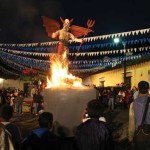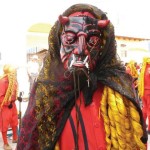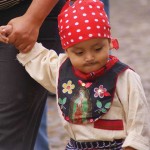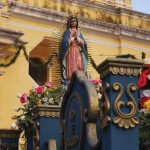Guatemala Holiday Calendar
All year he hides under the bed or in the junk piled up in the corner, casting misfortune or worse on helpless mortals. But on Monday, Dec. 7 at 6 p.m. sharp, the devil gets his comeuppance, as he is tossed out of the house along with the trash and set ablaze in the Quema del Diablo (Burning the Devil), a tradition in many Guatemalan towns that literally sparks the beginning of the Christmas season. —Juan Carlos Ordóñez
Dec. 7 & 8: Celebrations honoring the Virgen de Concepción featuring elaborate celebrations in Ciudad Vieja with parades and processions, fireworks and folkloric dances and dramas. Traditional food for sale includes estofado and pepián, a traditional Mayan meat dish made with a spicy sauce of chile gaugue and pasa, cilantro, tomato, onion, toasted sesame and pepitoria seeds. The favorite dessert on this holiday is crab apples (manzanillas) prepared en dulce. See related article on page 29 and photo spreads on pages 72 and 76.
Dec. 8 is also the official day for setting up nacimientos (nativity scenes) which is a strong family tradition in Guatemala that requires skill and a lot of patience. The scenes include Mary, Joseph and the baby Jesus (who is covered up until the 25th), also shepherds, a mule, an ox, sheep and three late-arriving Wise Kings. The finishing touch, an aromatic chamomile ring, creates the wonderful scent of a typical Guatemalan nativity. Nativities will not be put away until Feb. 2 when the traditional Christmas season comes to an end. —Desireé de Ceballos and Karla Ceballos (Casa de Artes, La Antigua) See related article on page 18.
On Dec. 12 the Virgen de Guadalupe is celebrated throughout the country. Many children dress in indigenous clothing and participate in parades and church blessings. One such procession begins at the La Merced Church in Antigua.
Dec. 15 marks the beginning of nightly Posadas in a reenactment of Mary and Joseph’s journey to Bethlehem. Pilgrims accompany them, singing carols, beating turtle shell drums and playing other typical Guatemalan instruments. They knock on doors seeking shelter but are turned away until they reach the designated home where everyone is invited inside. As the holy couple is bedded down in solemn ceremony, the pilgrims scramble for refreshments. The journey continues to another house the next night, for a total of nine nights.
On the 24th of December, Noche Buena/Christmas Eve, many are doing last minute Christmas shopping, visiting friends, catching buses bound for home. At 10pm the midnight Mass/Misa de Gallo) begins, celebrating the birth of Jesus. When the clock strikes midnight, Navidad / Christmas Day, Dec. 25) is celebrated with prayers, fireworks, good wishes, and traditional food is shared and enjoyed throughout the night. With the dawn comes time for rest, the day is quiet—with the exception of more fireworks and bombas at noon.
The traditional Christmas Eve dinner is tamales and of course punch that includes papayas, pineapple, crab apples, prunes, raisins, cinnamon, cloves and shredded coconut, served hot or cold when friends or family come to call. Hot chocolate is another holiday treat, as are buñuelos, fried puff pastry fritters served with syrup of molasses or brown sugar, anise and cinnamon.
Jan. 1: HAPPY NEW YEAR 2010



